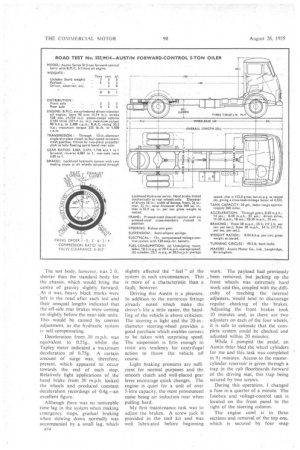The test body, however, was 2 ft. shorter than the
Page 48

Page 49

If you've noticed an error in this article please click here to report it so we can fix it.
standard body for the chassis, which would bring the centre of gravity slightly forward. As it was, heavy black marks were left in the road after each test and their unequal lengths indicated that the off-side rear brakes were coming on slightly before the near-side units. This would be caused by uneven adjustment, as the hydraulic system is self-compensating.
Deceleration from 30 m.p.h. was equivalent to 0.55g., whilst the Tapley meter indicated a maximum deceleration of 0.75g. A certain amount Of surge was, therefore,. present, which appeared to occur towards the end of each stop. Relatively light applications of the hand brake from 20 m.p.h. locked the wheels and produced constant deceleration recordings of 0.4g.—an excellent figure.
Although there was no noticeable time lag in the system when making emergency stops, gradual braking when slowing down normally, was accompanied by a small lag, which n14 slightly affected the " feel " of the system in such circumstances. This is more of a characteristic than a fault, however.
Driving this Austin is a pleasure. In addition to the numerous fittings already noted which make the driver's life a little easier, the handling of the vehicle is above criticism. The steering is light and the 20-in.diameter steering-wheel provides a good purchase which enables corners to be taken with surprising speed. The suspension is firm enough to resist any tendency for centrifugal action to throw the vehicle oft course.
Light braking pressures are sufficient for normal purposes and the smooth clutch and well-placed gear lever encourage quick changes. The engine is quiet for a unit of over 5-litre capacity, the most pronounced noise being air induction roar when pulling hard.
My first maintenance task was to adjust the brakes. A screw jack is provided in the tool kit and was well lubricated before beginning work. The payload had previously
• been removed, but jacking up the front wheels was extremely hard work and this, coupled with the difficulty of reaching the internal adjusters, would tend to discourage regular checking of the brakes. Adjusting the front brakes took 10 minutes and, as there are two Adjusters on each of the four wheels, it is safe to estimate that the complete system could be checked and adjusted within 20 minutes.
While I pumped the pedal. an Austin fitter bled the wheel cylinders for me and this task was completed in 91 minutes. Access to the mastercylinder reservoir is given through a trap in the cab floorboards forward of the driving seat, this trap being secured by two screws.
During this operation, I changed a fuse in a quarter of a minute. The fusebox and voltage-control unit is located on the front panel to the right of the steering column_
The engine cowl is in three sections and removal of the top one, which is secured by four snap
fasteners, is the work of a moment. All normal maintenance on the upper part of the engine can then be carried out with ease. The tappets were adjusted in 27 .minutes—the starter being used to turn the engine over—and I inspected and topped up the oil cleaner, which occupied 1,'*; minutes.
All six injectors are well exposed for removal, but as luck would have the injector that I decided to remove stuck in the cylinder head— a one-in-a-thousand chance. Removing the pipes and clamping bolts took 23, minutes, however, and replacement another 2 minutes, so in normal circumstances each injector should be changeable within 5 mi flutes.
Similarly, "the evil eye of automobile engineering" was watching me when I removed the main fuel filter element, because the rubber sealing ring which normally stays in the upper housing dropped out when
I removed the bowl and complicated the task. The element was changed and the system reprimed in 4 minutes, although the subsequent rough running of the engine suggested that the sealing ring might have decided not to be a proper seating.
All the normal fillers are readily to hand, except for the radiator filler. The engine cowl has to be removed to reach it. The gearbox and rear axle combined filler-andlevel plugs are provided with hexagonal heads to reduce the topping-up time, and the batteries are simplicity themselves to refill or otherwise service.
The tool kit is not particularly comprehensive, but this is the only criticism I have of an otherwise outstanding vehicle. Complete with a 16-ft. 6-in, timber drop-sided body, the Series III 5-ton oiler sells for £1,282 18s. 9d., including £176 18s. 9d. purchase tax.




































































































